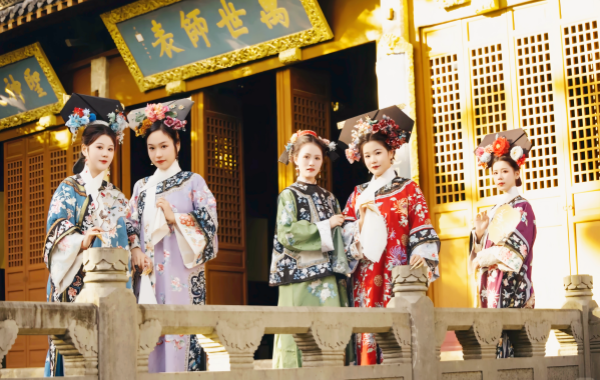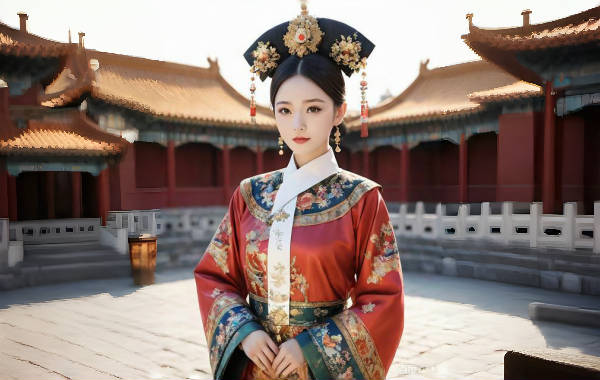Manchu
Introduction

The Manchu Nationality is one of the most prominent ethnic groups in China, with a rich and storied history. As the founders of the Qing Dynasty (1644 - 1912 AD), the Manchus played a pivotal role in shaping Chinese history and culture. Known for their unique customs, vibrant art forms, and strong sense of community, the Manchu people have maintained a distinct identity despite centuries of integration with the Han Chinese majority.
 History
History
· Origin
The Manchu people trace their origins to the Jurchen tribes, who inhabited the forests and plains of Northeast Asia. Over time, these tribes consolidated and formed the Jin Dynasty (1115 - 1234 AD). Later, under the leadership of Nurhaci and his successors, the Jurchens unified various tribes and established the Later Jin Dynasty, which eventually evolved into the Qing Dynasty.
· Development
During the Qing Dynasty, the Manchu people enjoyed a privileged status as the ruling class. They maintained their own language, customs, and military traditions while also adopting many aspects of Han Chinese culture. The Qing government implemented a series of policies to promote Manchu culture and identity, including the establishment of Manchu schools and the preservation of Manchu language and literature.
· Modern Times
In modern times, the Manchu people have undergone significant social and cultural changes. Following the fall of the Qing Dynasty in 1912, the Manchu aristocracy lost their political power, and many Manchus integrated into mainstream Chinese society. However, efforts have been made in recent decades to revive and preserve Manchu culture, including the promotion of the Manchu language, traditional arts, and customs.
 Population
Population
· Quantity
As of the latest census data, the Manchu population in China is approximately 10.4 million, making them the third-largest ethnic minority in the country after the Zhuang and Hui ethnic groups.
· Distribution
The Manchu people are primarily concentrated in Northeast China, particularly in Liaoning Province, which is considered the heartland of Manchu culture. There are also significant Manchu communities in Jilin, Heilongjiang, Beijing, Hebei, and Inner Mongolia. The widespread distribution of the Manchu people reflects their historical migration patterns and integration with other ethnic groups.
 Economy
Economy
Traditionally, the Manchu economy was based on a combination of agriculture, hunting, and fishing. In Northeast China, the fertile plains provided ideal conditions for farming, while the forests and rivers offered abundant resources for hunting and fishing. During the Qing Dynasty, the Manchu elite also engaged in trade and commerce, establishing a network of economic ties across China and beyond.
In modern times, the Manchu economy has diversified significantly. Many Manchus are now employed in various sectors, including industry, services, and agriculture. Tourism has also become an important source of income for some Manchu communities, particularly those located in areas with rich cultural heritage and natural beauty.
 Culture
Culture
· Language and Script
The Manchu language belongs to the Tungusic branch of the Altaic language family. It has its own unique script, known as the Manchu script, which was created in the early 17th century based on the Mongolian script. The Manchu script was widely used during the Qing Dynasty for official documents, literature, and historical records. However, with the decline of the Manchu language in modern times, the script is now considered endangered, and efforts are being made to preserve and revitalize it through education and cultural programs.
· Religious Beliefs
Shamanism has deep roots in Manchu culture, with shamans playing a central role in spiritual and healing practices. Manchu shamans communicate with the spirit world through rituals and ceremonies, seeking guidance and protection for their community. In addition to Shamanism, many Manchus also practice Buddhism, particularly Tibetan Buddhism and Han Buddhism. Confucianism and Taoism have also had an influence on Manchu religious beliefs and practices.

· Clothing
Traditional Manchu clothing is known for its elegance and distinctiveness. Men typically wear long gowns with narrow sleeves and high collars, paired with trousers and boots. Women wear long dresses with elaborate embroidery and decorations, often accessorized with jewelry and hair ornaments. The most iconic Manchu garment is the qipao (cheongsam), which originated as a loose-fitting dress for Manchu women and later evolved into a form-fitting, elegant gown that became popular among women across China.
· Literature
Manchu literature has a rich and diverse tradition, encompassing poetry, prose, history, and folklore. Many Manchu writers and poets have made significant contributions to Chinese literature, using both the Manchu and Chinese languages. Manchu folklore is particularly vibrant, with stories of gods, heroes, and animals that reflect the people's beliefs, values, and historical experiences.
· Transportation
Traditionally, the Manchu people relied on horses for transportation, particularly in the rural areas of Northeast China. Horses were used for riding, pulling carts, and carrying loads. In modern times, the Manchu people have adopted modern modes of transportation such as cars, buses, and trains, although horses are still used in some traditional festivals and ceremonies.
 Science
Science
· Medicine
Traditional Manchu medicine is based on a combination of herbal remedies, massage, and spiritual practices. Manchu healers use a variety of plants and animals to treat various ailments, reflecting their deep understanding of the natural world and its healing properties. In recent years, there has been growing interest in integrating traditional Manchu medicine with modern healthcare systems to provide more comprehensive and culturally sensitive care.
· Calendar
The Manchu people have their own traditional calendar, which is based on the lunar cycle and incorporates elements of both Shamanism and Buddhism. The calendar is used to guide agricultural activities, mark important cultural events and festivals, and determine auspicious dates for weddings and other ceremonies.
 Art
Art
· Music
Manchu music is characterized by its melodic beauty and rhythmic complexity. Traditional Manchu instruments include the hulusi (a gourd-shaped wind instrument), the suona (a double-reed horn), and various types of drums and flutes. Manchu songs often tell stories of love, nature, and history, captivating listeners with their emotional depth and cultural significance.
· Dance
Manchu dance is vibrant and expressive, with movements that reflect the people's connection to nature and their spiritual beliefs. Traditional Manchu dances are often performed during festivals and celebrations, bringing people together in joy and harmony. Dancers wear colorful costumes and perform intricate footwork and hand gestures, reflecting the people's artistic talents and cultural traditions.
· Architecture
Traditional Manchu architecture is known for its grandeur and practicality. Manchu buildings often feature distinctive roofs with upturned eaves, which are designed to prevent snow and rain from accumulating. The interior of Manchu houses is typically divided into separate areas for living, sleeping, and cooking, with a focus on functionality and comfort. In modern times, many Manchu buildings have incorporated elements of modern architecture, although traditional styles are still preserved in some historical sites and cultural villages.
· Landscape
The Manchu landscape is characterized by vast forests, rolling hills, and pristine rivers and lakes. Northeast China, the heartland of Manchu culture, is home to some of China's most beautiful natural scenery, including the Changbai Mountains and the Songhua River. This natural beauty has inspired many Manchu artists and poets throughout history, who have captured the essence of the region in their works.
· Arts and Crafts
Manchu arts and crafts are renowned for their exquisite craftsmanship and unique designs. Traditional Manchu crafts include embroidery, carving, painting, and metalwork, each reflecting the people's artistic talents and cultural traditions. Many Manchu artisans have passed down their skills from generation to generation, preserving these ancient crafts for future generations to appreciate and enjoy. Manchu handicrafts are often sold as souvenirs to tourists, providing an important source of income for the community.
 Custom
Custom
· Etiquette
Manchu etiquette is based on respect, politeness, and hospitality. When visiting a Manchu home, guests are typically offered tea and snacks as a sign of welcome and friendship. It is considered impolite to refuse these offerings or to show disrespect to elders and guests. Manchu people also place great importance on personal hygiene and cleanliness, reflecting their connection to nature and their spiritual beliefs.
· Marriage Customs
Manchu marriage customs are characterized by their traditional rituals and family involvement. Marriages are typically arranged by the families of the bride and groom, with the consent of the couple involved. The wedding ceremony is a grand affair, with prayers and blessings offered by elders and shamans. After the ceremony, the newlyweds move into their own home, which is often provided by the groom's family.
· Festivals
The Manchu people celebrate several important festivals throughout the year, including the Spring Festival (Chinese New Year), the Lantern Festival, and the Mid-Autumn Festival. These festivals are marked by feasting, dancing, and traditional games and activities, reflecting the importance of community and family in Manchu culture. In addition to these festivals, the Manchu people also celebrate specific cultural festivals that honor their history and traditions, such as the Banjin Festival, which commemorates the founding of the Manchu ethnic group.
· Diet
Manchu cuisine is a blend of traditional Manchu dishes and influences from Han Chinese and other ethnic cuisines. Traditional Manchu dishes include stewed meat, grilled fish, and various types of dumplings and noodles. Manchu people also have a tradition of preserving food, such as making pickles and dried meat, which allows them to enjoy these foods throughout the year. In modern times, the Manchu diet has become more diverse, incorporating elements of international cuisine as well.
· Funeral Customs
Manchu funeral customs are based on respect for the deceased and the belief in an afterlife. The body is typically washed and dressed in new clothes before being placed in a coffin or wrapped in a shroud. Funeral prayers and rituals are performed by shamans or elders to guide the soul of the deceased to the afterlife. Family and friends gather to pay their respects and offer condolences, and a feast is held to honor the memory of the deceased. The mourning period lasts for several days, during which time relatives and friends visit the family of the deceased to offer support and comfort.
What Our Clients Say?
Based on 10,000+ traveler reviews











